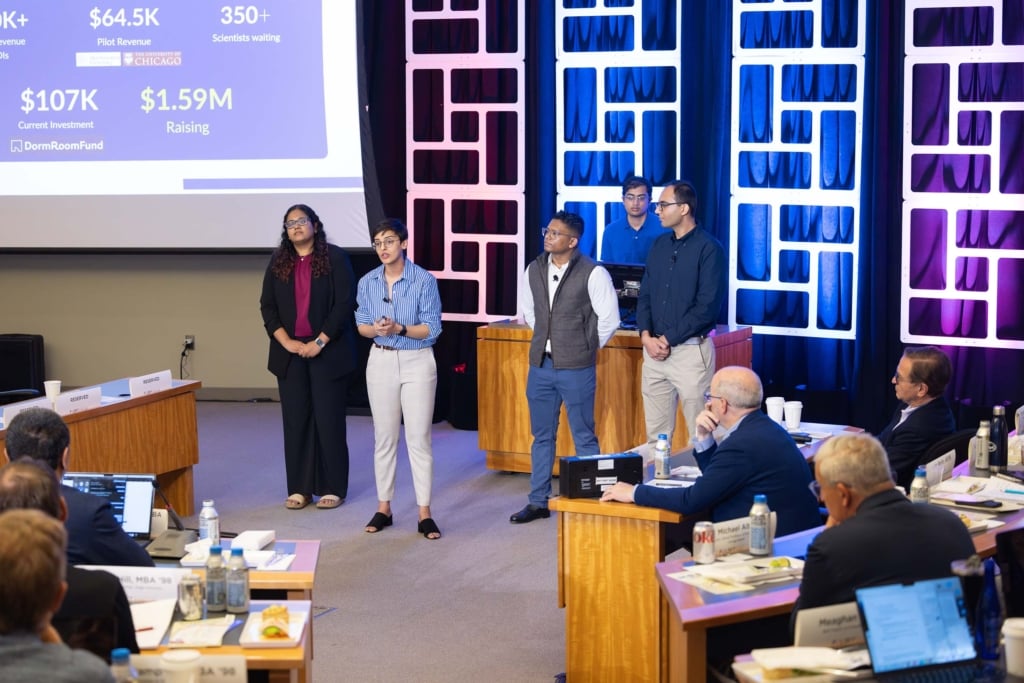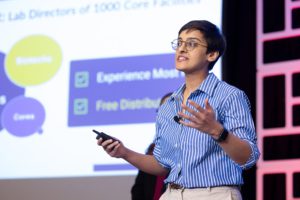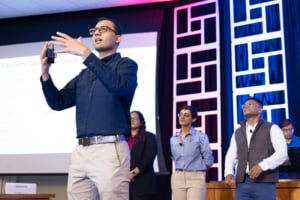How Rayni Turned Scientific Frustration Into a Victory at the 2025 New Venture Challenge

Rayni presenting at the 2025 Edward L. Kaplan, ’71, New Venture Challenge
Sakshi Nag came to Booth with a clear goal: start a company that helped scientists.
“I worked in the controls department at Fermilab, writing software for particle accelerators,” said Nag, cofounder and CEO of Rayni, an AI platform that helps scientists operate complex lab instruments. “That’s where I first saw how much time scientists lose just trying to get their tools to work.”
Across labs — physics, chemistry, pharma — she saw the same issues: hard-to-use machines, constant troubleshooting, and lost time and money. “These are brilliant people, but they’re stuck fixing equipment instead of doing research,” she said.
She set out to solve the problem, hoping to help modernize that lab experience. She had the experience in the lab, but wanted to learn the business side as well, so she applied to the University of Chicago Booth School of Business with the goal of launching a business.
Meanwhile, Divyanshu Sharma, cofounder of Rayni, came to Chicago Booth with a different background, but the same goal of starting a company.
A B2B SaaS builder with technical roots, Sharma had spent his time before business school building enterprise platforms in cybersecurity.
“My job was keeping nation-state hackers out of universities and corporations,” he said. “I wanted to apply that experience to a new, meaningful problem.”
Both founders came to Chicago Booth with the intention of building — and quickly found common ground.
“I had this idea rooted in science, and Divyanshu brought the experience of building large-scale, AI-powered platforms,” said Nag. “We had complementary skills, and we both wanted to work on something that mattered.”
The First Attempt

Sakshi Nag, CEO and cofounder, Rayni
In her first quarter, Nag took Entrepreneurial Discovery with Adjunct Professor of Entrepreneurship Mark Tebbe and brought him her early idea: a company that would build custom controls for scientists.
“He asked me, ‘Okay, what do you do after you sell it to all ten of your customers?’” she recalled. “And he was right. There just weren’t enough customers for it to be a scalable business.”
That feedback sparked a broader round of customer discovery. “I started interviewing scientists and asked them about their biggest problems. The responses were valuable, and I noticed a lot of patterns, but I didn’t yet know how to build something from it,” she said. “So I shelved the idea.”
Still, that experience gave her a foundation in problem-finding and design.
The Second Attempt
Next came a hydroponic plant venture — the first concept that Nag and Sharma built together.
“We started prototyping and even selling,” said Sharma. “But it was a post-sale service with low margins and low urgency. Customers didn’t have a strong willingness to pay.”
It was, however, their first time working together on a startup, and it taught them when to pivot.
“We learned how to accept when something wasn’t working,” Nag said. “That’s not easy, especially when it’s something you’ve put real time into, but ultimately pivoting to something else was the right move. And it’s a lesson that we brought with us.”
The Third Time’s the Charm
After deciding to walk away from the plant idea, they went back to the basics. They sat in front of a whiteboard and listed ideas.
That’s when the earlier interviews Nag had done with scientists came back into focus.
“I remembered how many scientists talked about struggling to operate their microscopes and other instruments,” she said. “At the time, I didn’t think much of it. But as we were exploring business ideas, I figured let’s give it another look.”
As they began reading through her interview transcripts with scientists, the dots started to connect.
“We were seeing everything you look for in a business — urgent need, repeated across domains, with no good solution in place,” Sharma said. “The emotional pain was there, frustration, the lost time.”
“That was the moment Rayni was born.”
A couple of weeks before the Polsky Center’s Build Accelerator kicked off, they submitted their application.
“We didn’t have all the answers yet,” Nag said. “But we knew there was something there, and we were ready to pursue it.”
Building with Polsky and Chicago Booth

Divyanshu Sharma, cofounder of Rayni
Through the Build Accelerator, Nag and Sharma refined their idea, did focused customer discovery, and were paired with mentors.
“Build wasn’t just helpful, it was essential,” said Nag. “That’s where we laid the groundwork for Rayni.”
Their success in the Build accelerator gave them momentum heading into the 2025 Edward L. Kaplan, ’71, New Venture Challenge (NVC), where Rayni would go on to win the Rattan L. Khosa First-Place Prize of $895,000, the largest share of a record-breaking $2.2 million in total awards.
Chicago Booth classes shaped their path as well – Entrepreneurial Selling taught them to pitch their idea and Accounting for Entrepreneurship helped them structure the business.
They also talked to past NVC participants, both those who won and those who didn’t, to learn what really mattered.
“We changed our strategy a lot along the way,” said Sharma. “And that was okay. The advice we got, along with our previous experience, helped us realize when to pivot and how to keep going.”
What’s Next for Rayni
Rayni’s AI-powered platform helps scientists troubleshoot and operate complex lab equipment, like microscopes and mass spectrometers.
“Think of it like this,” said Nag. “If you’re baking a pizza, you care about the ingredients and how it tastes — not how the oven’s vacuum tubes work. But that’s exactly the position scientists are in. They’re forced to learn the machine, not just do the experiment.”
With Rayni, scientists get step-by-step guidance and instant support so they can focus on discovery instead of diagnostics.
Now, with the NVC behind them, the team is focused on closing their fundraising round, building out their engineering team, and preparing for further deployment in labs.
“In a year, we’re aiming to have a mature product, in multiple labs, generating more revenue and bringing smiles and joy to scientists as they experience less emotional frustration and get to focus on the part of the job that makes an impact on the world,” said Sharma.
Looking back, both founders credit their failures – not in spite of them, but because of them.
“Each time we tried and failed, we got a little further,” Nag said. “First, it was just an idea. Then we learned how to prototype and sell. Rayni is the third time — and it’s the charm.”